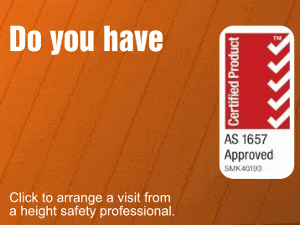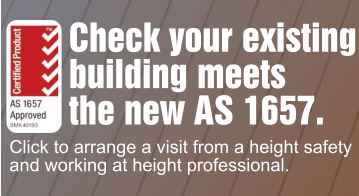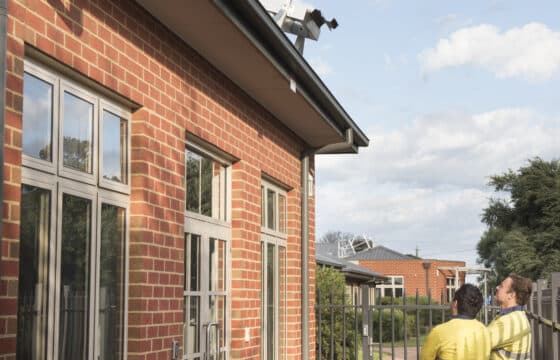AS 1657: Understanding the AS 1657 height safety standard
AS1657 remains one of Australia’s highest selling standards.
The standard is referenced in the National Construction Code (NCC), more commonly referred to as the BCA (Building Code of Australia). It is one of the most widely referenced Australian standards for safety and access purposes in workplace health and safety legislation and construction codes and regulations.
Stairways
The requirements for stairways and staircases used for access and egress for plant rooms, fire and emergency egress and roof access are prescribed in AS1657-2018. The incline of the stairways, risers and goings, clearances around entrance and exit points, handrail measurements, loadings and labelling requirements are all detailed and prescribed.
Whilst deemed to comply measurements are provided, an alternate means of meeting performance based requirements are detailed in an appendix for testing in the appendix F of AS1657 (page73 onwards). Easy to use selection criteriaare prescribed in appendix G and safe design , installation and use information on page 90.
The most recent changes were dimensional changes to platforms (relating to ladders) and are encapsulated in Clause 7.3.6(a) and Fig 7.5. Compare the two clauses:
“The minimum length of the landing shall be not less than 900 mm, measured
horizontally from the front of the ladder.” – AS 1657: 2013
versus
“The minimum length of the landing shall be not less than 900 mm, measured horizontally from the face of the lowest rung of the ladder, as shown in Figure 7.5.” – AS 1657: 2018.
The chart provided in Figure 2.1, is an easy to use way of selecting the most appropriate means of access and egress.
Guardrail and handrails.
Widely used for fall protection and height safety, fixed guardrail and handrail requirements are outlined as a recipe if you want to build your own.
The AS1657 standard provides dimensional “deemed to comply” requirements for guardrail and handrails, particularly heights, rail and staunchion sizing for aluminium and steel, spacings of upright staunchions and the spacing between top rails and mid rails.
Performance based solutions are available by using the testing requirements in appendix B (page 62), which provide for an alternate means of proving staunchion spacings of different shapes, materials and sizes of post and staunchion materials.
Whilst the fundamental testing requirements are largely changed since AS1657-1992 was published, there is more clarification and prescription surrounding testing to bring it in line with NATA’s (National Association of Testing) requirements to meet ISO17025.
Figure 4.1 provides a means of determining the actual location and clearances of guardrailing when designing or inspecting existing equipment.
Key dimensions for deemed to comply guardrailing are provided in Figure 6.1.
Ladders (Step type and rung type)
Widely used for roof access for height safety, rung ladder and step type ladder dimensions are provided in simple charts and drawings. Seven different tests for checking stile strength, rung strength and deflection, are detailed in Appendif F, Testing of Fixed Ladders.
Whilst only brought in since AS1657-2014, this type of testing has been applied for many years in the around for years in the AS/NZS1891 standards for portable ladders, and widely used for mobile ladders.
Fixed type ladders are widely referenced in occupational health and safety laws and the workcover authorities code of practice and guidance material.
Attic type, retractable ladders.
Whilst not directly referenced in AS1657, the dimensional and structural aspects of fixed ladders are used to design attic type ladders. Rung sizes, strengths and testing requirements are easily cross used to make sure that these ladders are safe and fit for purpose in workplaces.
Put simply, Australian Standard AS 1657 is a benchmark for what is considered “reasonably practicable” in a court of law rather than a complete user guide to practical height safety. It does not pretend to cover the other elements enshrined in OHS practice.
AS 1657 needs to be understood in the context of height safety, falls regulations, codes, the WHS Act and the workplace itself.
This is particularly stark when it comes to the consideration of the task and user skill levels. Height safety measures when accessing air-conditioners, for example, needs to be quite different from that in a school environment.
While both must follow the unique hierarchy of controls set out in the falls regulations, the frequency of the task pales into insignificance. The risk to the typical PE teachers faced with retrieving a wayward ball using a harness-based system is much higher than for professional riggers scaling a mast.
The 2018 edition of AS 1657 is certainly an improvement on the 2013 standard but use it with caution and engage an expert to help interpret the sometimes apparently conflicting guidance it provides.
It’s almost time for another rewrite to bring it in line with current practices and state of knowledge in industry.
-
Do you have specs that need to be updated to meet the new AS 1657:2018?
The new AS 1657 is already in place, so now is the time to check your compliance. Make it painless with Workplace Access & Safety – simply click below to arrange a chat with one of our height safety specialists
-
Check if your new building meets the new AS 1657
Now is the time to check your compliance and equip yourself with the right information to make height safety straightforward. Simply click below to arrange a chat with one of our height safety specialists.
Like to know how the new changes will affect your site? Contact us today on 1300 552 984 or email [email protected]
About the author:
Carl Sachs is a director of Workplace Access & Safety, the market leader for inspections and advice.Proudly independent of any particular contracting business or manufacturers, Workplace Access & Safety is accredited by SAI Global to design, inspect and risk assess AS 1657 equipment. The business is is accredited by NATA (National Association of Testing Laboratories) for the testing and inspection of AS 1657 equipment. .
For independent advice and inspections, contact us today.




